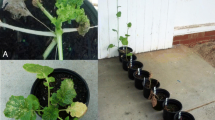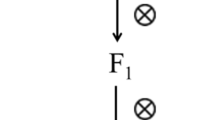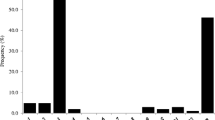Abstract
Preliminary studies were undertaken to establish the occurrence of Turnip mosaic virus (TuMV) resistance phenotypes in 99 Brassica napus and 32 B. carinata accessions, breeding lines and cultivars mostly from Africa, Australia, the Indian sub-continent or China. An isolate of TuMV pathotype 8 (WA-Ap1) was used in most inoculations. The influence of temperature on expression of resistance phenotypes was determined. Those identified were O (extreme resistance), RN (localised hypersensitivity), R (resistance to systemic movement without necrosis), +N (systemic infection with some necrosis), + (susceptibility), and RN/+ (systemic infection with necrosis limited to inoculated leaves). In the initial glasshouse evaluations with B. napus, 18 lines developed phenotype O, 42 RN, two + (both from Australia), and 30 segregated for O and RN, two for R and RN, one for O and R, two for O, R and RN, one for O, RN and +N, and one for RN and +N. Phenotype +N only occurred in two lines from India. In the initial glasshouse evaluations with B. carinata, 14 lines developed O, two RN or R, and one +; the 13 remaining lines segregated for phenotypes O and R (12), or RN and R (1). In B. carinata, phenotype RN only occurred in African lines, and phenotype + only in a line from Pakistan. The 18 B. napus and 14 B. carinata lines that developed phenotype O uniformly were re-evaluated at low (16 and/or 18 °C) and high (25 °C) temperatures in the glasshouse three or two times, respectively, and again under controlled environment room conditions at 16 and at 28 °C. While in most lines phenotype O was replaced by other phenotypes or segregated with other phenotypes at the higher temperatures, it occurred uniformly regardless of temperature in Chinese B. napus line (06-6-3777) and three African B. carinata lines (IP 117, ST 18 and ST 50). Graft inoculations confirmed extreme resistance in these four lines. Other promising lines which displayed phenotype O in >75 % of inoculated plants included for B. napus Chinese lines 06-p71-1 and 06-p74-4 and French line Cresor, and for B. carinata African lines Mbeya Green, ML-EM-1, ML-EM-7 and ML-EM-8, and Australian lines P 195923.3 and 30200533. Five promising lines segregated for phenotype RN, B. napus Ding 110, Hyola 42, Fan 028, ZY 007 and Qu 1104. Chinese B. napus line Ding 110 developed phenotype RN uniformly at high (25 and 28 °C) temperatures. Thus, in plants developing phenotypes RN, R and +, low temperature retarded virus multiplication in inoculated leaves to below the level at which it can be identified using ELISA. No clear phenotypic differences attributable to TuMV pathotype were found in tests in which isolates from pathotypes 1, 7 and 8 were used. This highlights the need for future evaluations for TuMV resistance in Brassica germplasm to be done at higher temperatures. This study also highlights the need to identify additional genes responsible for the different resistance and susceptibility reactions found, especially in B. carinata. The four lines that developed phenotype O uniformly at all temperatures and also withstood graft-inoculation will be particularly valuable for developing new TuMV-resistant cultivars of oilseed and forage Brassicas.


Similar content being viewed by others
References
Atreya, K., Johnsen, F., & Sitaula, B. (2012). Health and environmental costs of pesticide use in vegetable farming in Nepal. Environment, Development and Sustainability, 14, 477–493.
Babu, B., Dankers, H., George, S., Wright, D., Marois, J., & Paret, M. (2013). First report of Turnip mosaic virus infecting Brassica carinata (Ethiopian mustard) in the United States. Plant Disease, 97, 1664.
Barbetti, M. J., Banga, S. S., & Salisbury, P. A. (2012). Challenges for crop production and management from pathogen biodiversity and diseases under current and future climate scenarios – case study with oilseed Brassicas. Field Crops Research, 127, 225–240.
Boyko, V., Ferralli, J., & Heinlein, M. (2000). Cell-to-cell movement of TMV RNA is temperature-dependent and corresponds to the association of movement protein with microtubules. Plant Journal, 22, 315–325.
Chauhan, J. S., Singh, K. H., & Kumar, A. (2006). Compendium of rapeseed-mustard varieties notified in India. Bharatpur: National Research Centre on Rapeseed-Mustard (ICAR).
Clark, M. F., & Adams, A. N. (1977). Characteristics of the microplate method of enzyme-linked immunosorbent assay for the detection of plant viruses. Journal of General Virology, 34, 475–483.
Coutts, B. A., & Jones, R. A. C. (2000). Viruses infecting canola (Brassica napus) in south-west Australia: incidence, distribution, spread, and infection reservoir in wild radish (Raphanus raphanistrum). Australian Journal of Agricultural Research, 51, 925–936.
Coutts, B. A., Walsh, J. A., & Jones, R. A. C. (2007). Evaluation of resistance to Turnip mosaic virus in Australian Brassica napus genotypes. Australian Journal of Agricultural Research, 58, 67–74.
Coutts, B. A., Webster, C. G., & Jones, R. A. C. (2010). Control of Beet western yellows virus in Brassica napus crops: infection resistance in Australian genotypes and effectiveness of imidacloprid seed dressing. Crop and Pasture Science, 61, 321–330.
Dixon, G. R. (2007). Vegetable Brassicas and related crucifers. Wallingford: CAB International.
Foster, J. A., & Ross, A. F. (1975). The detection of symptomless virus-infected tissue in inoculated tobacco leaves. Phytopathology, 65, 600–610.
Fraser, R. S. S. (1990). The genetics of resistance to plant viruses. Annual Review of Plant Pathopathology, 28, 179–200.
Fraser, R. S. S., & Laughlin, S. A. R. (1982). Effects of temperature on the Tm-1 gene for resistance to tobacco mosaic virus in tomato. Physiological Plant Pathology, 20, 109–117.
Garrett, K. A., Dendy, S. P., Frank, E. E., Rouse, M. N., & Travers, S. E. (2006). Climate change effects on plant disease: genomes to ecosystems. Annual Review of Phytopathology, 44, 489–509.
Gladysz, K., & Hanus-Fajerska, E. (2009). Evaluation of the infectivity of selected Turnip mosaic virus isolates towards white cabbage cultivars. Folia Horticulturae, 21, 129–138.
Górecka, K., & Lehmann, P. (2001). Infectious diseases of horseradish (Cochlearia arnoracia L.) in Poland. Plant Breeding and Seed Science, 45, 55–64.
Green, S. K., & Deng, T. C. (1985). Turnip mosaic virus strains in cruciferous hosts in Taiwan. Plant Disease, 69, 28–31.
Hardwick, N. V., Davies, J. M. L., & Wright, D. M. (1994). The incidence of three virus diseases of winter oilseed rape in England and Wales in the 1991/92 and 1992/93 growing seasons. Plant Pathology, 43, 1045–1049.
Harrison, B. D., & Jones, R. A. C. (1971). Effects of light and temperature on symptom development and virus content of tobacco leaves infected with potato mop-top virus. Annals of Applied Biology, 67, 377–387.
Hobbs, H. A., Jossey, S., Wang, Y., Hartman, G. L., & Domier, L. L. (2012). Diverse soybean accessions identified with temperature-sensitive resistance to Tobacco streak virus. Crop Science, 52, 738–744.
Hughes, S. L., Green, S. K., Lydiate, D. J., & Walsh, J. A. (2002). Resistance to Turnip mosaic virus in Brassica rapa and B. napus and the analysis of genetic inheritance in selected lines. Plant Pathology, 51, 567–573.
Hughes, S. L., Hunter, P. J., Sharpe, A. G., Kearsey, M. J., Lydiate, D. J., & Walsh, J. A. (2003). Genetic mapping of the novel Turnip mosaic virus resistance gene TuRB03 in Brassica napus. Theoretical and Applied Genetics, 107, 1169–1173.
Hunter, P. J., Jones, J. E., & Walsh, J. A. (2002). Involvement of Beet western yellows virus, Cauliflower mosaic virus and Turnip mosaic virus in internal disorders of stored white cabbage. Phytopathology, 92, 816–826.
Jenner, C. E., Tomimura, K., Ohshima, K., Hughes, S. L., & Walsh, J. A. (2002). Mutations in Turnip mosaic virus P3 and cylindrical inclusion proteins are separately required to overcome two Brassica napus resistance genes. Virology, 300, 50–59.
Jenner, C. E., & Walsh, J. A. (1996). Pathotypic variation in turnip mosaic virus with special reference to European isolates. Plant Pathology, 45, 848–856.
Jenner, C. E., Wang, X., Tomimura, K., Ohshima, K., Ponz, F., & Walsh, J. A. (2003). The dual role of the potyvirus P3 protein of Turnip mosaic virus as a symptom and avirulence determinant in Brassicas. Molecular Plant-Microbe Interactions, 16, 777–784.
Jiang, Y., Tian, E., Li, R., Chen, L., & Meng, J. (2007). Genetic diversity of Brassica carinata with emphasis on the interspecific crossability with B. rapa. Plant Breeding, 126, 487–491.
Jones, R. A. C. (1973). Effects of heat shock treatment on symptom development in tobacco leaves inoculated with potato mop-top virus. Annals of Applied Biology, 74(3), 349–358.
Jones, R. A. C. (2001). Developing integrated disease management strategies against non-persistently aphid-borne viruses: a model programme. Integrated Pest Management, 6, 15–46.
Jones, R. A. C. (2004). Using epidemiological information to develop effective integrated virus disease management strategies. Virus Research, 100, 5–30.
Jones, R. A. C. (2006). Control of plant virus diseases. Advances in Virus Research, 67, 205–244.
Jones, R. A. C. (2009). Plant virus emergence and evolution: origins, new encounter scenarios, factors driving emergence, effects of changing world conditions, and prospects for control. Virus Research, 141, 113–130.
Jones, R. A. C., & Barbetti, M. J. (2012). Influence of climate change on plant disease infections and epidemics caused by viruses and bacteria. CAB Reviews: Perspectives in Agriculture, Veterinary Science, Nutrition and Natural Resources, 7(22), 1–32. www.cabi.org/cabreviews.
Kassanis, B., & MacCarthy, D. (1967). The quality of virus as affected by the ambient temperature. Journal of General Virology, 1, 425–440.
Kehoe, M. A., Coutts, B. A., & Jones, R. A. C. (2010). Resistance phenotypes in diverse accessions, breeding lines, and cultivars of three mustard species inoculated with Turnip mosaic virus. Plant Disease, 94, 1290–1298.
Li, C. X., Li, H., Sivasithamparam, K., Fu, T. D., Li, Y. C., Liu, S. Y., et al. (2006). Expression of field resistance under Western Australian conditions to Sclerotinia sclerotiorum in Chinese and Australian Brassica napus and Brassica juncea germplasm and its relation with stem diameter. Australian Journal of Agricultural Research, 57, 1131–1135.
Li, C. X., Li, H., Siddique, A. B., Sivasithamparam, K., Salisbury, P., Banga, S. S., et al. (2007). The importance of the type and time of inoculation and assessment in the determination of resistance in Brassia napus and B. juncea to Sclerotinia sclerotiorum. Australian Journal of Agricultural Research, 58, 1198–1203.
Li, C. X., Liu, S. Y., Sivasithamparam, K., & Barbetti, M. J. (2009). New sources of resistance to Sclerotinia stem rot caused by Sclerotinia sclerotiorum in Chinese and Australian Brassica napus and B. juncea germplasm screened under Western Australian conditions. Australasian Plant Pathology, 38, 149–152.
Liu, X. P., Lu, W. C., Liu, Y. K., & Li, J. L. (1990). A study of TuMV strain differentiation of cruciferous vegetables from ten provinces of China. Chinese Science Bulletin, 35, 1734–1739.
Llamas-Llamas, M. E., Zavaleta-Mejia, E., Gonzalez-Hernandez, V. A., Cervantes-Diaz, L., Santizo-Rincon, J. A., & Ochoa-Martinez, D. L. (1998). Effect of temperature on symptom expression and accumulation of tomato spotted wilt virus in different host species. Plant Pathology, 47, 341–347.
Lozoya-Saldana, H., & Dawson, W. O. (1982). Effect of alternating temperature regimes on reduction or elimination of viruses in plant tissues. Phytopathology, 72, 1059–1064.
Rakow, G. W., & Woods, D. L. (1987). Outcrossing in rape and mustard under Saskatchewan prairie conditions. Canadian Journal of Plant Science, 67, 147–151.
Rusholme, R. L., Higgins, E. E., Walsh, J. A., & Lydiate, D. J. (2007). Genetic control of broad-spectrum resistance to Turnip mosaic virus in Brassica rapa (Chinese cabbage). Journal of General Virology, 88, 3177–3186.
Sánchez, F., Rodríguez-Mateos, M., Touriño, A., Fresno, J., Gómez-Campo, C., Jenner, C. E., et al. (2007). Identification of new isolates of Turnip mosaic virus that cluster with less common viral strains. Archives of Virology, 152, 1061–1068.
Schuerger, A. C., & Hammer, W. (1995). Effects of temperature on disease development of tomato mosaic virus in Capsicum annuum in hydroponic systems. Plant Disease, 79, 880–885.
Shattuck, V. I., & Stobbs, L. W. (1987). Evaluation of rutabaga cultivars for turnip mosaic virus resistance and the inheritance of resistance. Hortscience, 22, 935–937.
Spence, N. J., Phiri, N. A., Hughes, S. L., Mwaniki, A., Simons, S., Oduor, G., et al. (2007). Economic impact of Turnip mosaic virus, Cauliflower mosaic virus and Beet mosaic virus in three Kenyan vegetables. Plant Pathology, 56, 317–323.
Stefanski, E. P., Garcia, S. C., Farina, S. R., Tan, K. Y., & Tanner, D. (2010). Effects of sowing rate and grazing management of forage rape (Brassica napus) on grazing behaviour and utilisation by dairy cattle. Animal Production Science, 50, 560–567.
Thresh, J. M. (1982). Cropping practices and virus spread. Annual Review of Phytopathology, 20, 193–218.
Thresh, J. M. (2006). Control of tropical plant virus diseases. Advances in Virus Research, 67, 245–295.
Wallace, A. C. (2007). Genetic diversity in Australian canola and implications for crop breeding for changing future environments. Field Crops Research, 104, 103–111.
Walsh, J. A. (1989). Genetic-control of immunity to turnip mosaic-virus in winter oilseed rape (Brassica-napus ssp oleifera) and the effect of foreign isolates of the virus. Annals of Applied Biology, 115, 89–99.
Walsh, J. A., & Jenner, C. E. (2002). Turnip mosaic virus and the quest for durable resistance. Molecular Plant Pathology, 3, 289–300.
Walsh, J. A., & Jenner, C. E. (2006). Resistance to Turnip mosaic virus in the Brassicaceae. In: G. Loebenstein, & J. P. Carr (Eds.), Natural Resistance Mechanisms of Plants to Viruses (pp. 415–430). Netherlands: Springer.
Walsh, J. A., Perrin, R. M., Miller, A., & Laycock, D. S. (1989). Studies on beet western yellows virus in winter oilseed rape (Brassica napus ssp. oleifera) and the effect of insecticidal treatment on its spread. Crop Protection, 8, 137–143.
Walsh, J. A., & Tomlinson, J. A. (1985). Viruses infecting winter oilseed rape (Brassica napus ssp. oleifera). Annals of Applied Biology, 107, 485–495.
Walsh, J. A., Sharpe, A. G., Jenner, C. E., & Lydiate, D. J. (1999). Characterisation of resistance to turnip mosaic virus in oilseed rape (Brassica napus) and genetic mapping of TuRB01. Theoretical and Applied Genetics, 99, 1149–1154.
Walsh, J. A., Rusholme, R. L., Hughes, S. L., Jenner, C. E., Bambridge, J. M., Lydiate, D. J., et al. (2002). Different classes of resistance to Turnip mosaic virus in Brassica rapa. European Journal of Plant Pathology, 108, 15–20.
Wang, H.-Y., Liu, J.-L., Gao, R., Chen, J., Shao, Y.-H., & Li, X.-D. (2009). Complete genomic sequence analyses of Turnip mosaic virus basal-BR isolates from China. Virus Genes, 38, 421–428.
Yoon, J. Y., Green, S. K., & Opeña, R. T. (1993). Inheritance of resistance to turnip mosaic virus in chinese cabbage. Euphytica, 69, 103–108.
Acknowledgments
The first author gratefully acknowledges the financial assistance of a Scholarship for International Research Fees (SIRF), operational funding support provided by the School of Plant Biology, The University of Western Australia and the Department of Agriculture and Food Western Australia, help with ELISA sample testing by Eva Gajda, and the provision of TuMV isolates by Brenda Coutts. Seeds of various Brassica lines used were provided by a previous Australian Centre for International Agricultural Research Project with India and China which was jointly funded with the Grain's Research and Development Corporation, or, for B. carinata lines, by the Asian Vegetable Research and Development Centre (AVRDC), Tanzania.
Author information
Authors and Affiliations
Corresponding author
Rights and permissions
About this article
Cite this article
Nyalugwe, E.P., Barbetti, M.J. & Jones, R.A.C. Preliminary studies on resistance phenotypes to Turnip mosaic virus in Brassica napus and B. carinata from different continents and effects of temperature on their expression. Eur J Plant Pathol 139, 687–706 (2014). https://doi.org/10.1007/s10658-014-0423-8
Accepted:
Published:
Issue Date:
DOI: https://doi.org/10.1007/s10658-014-0423-8




